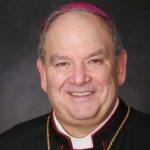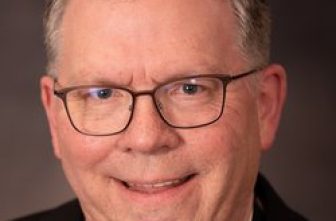The bishops of our ecclesiastical province (consisting of the 10 dioceses of Minnesota, North Dakota and South Dakota) recently gathered for our annual August meeting, hosted this year by the Diocese of Winona-Rochester. While there is always a business element to the gatherings, there are also opportunities for the bishops to pray together and to spend time together in a way that enables us to build the fraternal communion that the Church expects of her bishops.
Our province is somewhat unusual, given that so many of the bishops are relatively new to our assignments. Since 2020, I have had the privilege of ordaining or installing all the other bishops in Minnesota as well as the two bishops in South Dakota. That is pretty remarkable. Only our two brothers in North Dakota have been here longer than I have. In this context, our time together becomes a golden opportunity for building relationships to serve our local Churches. I always find it both helpful and inspiring to learn what is going on in the other dioceses, as we together recognize both the uniqueness of our individual dioceses and the threads of common experience that unite us as a province.

We were blessed this year by two excellent presentations. The first, by Msgr. Kieran Harrington, focused on the importance of diocesan support for the four Pontifical Mission Societies: the Society for the Propagation of the Faith (supporting the evangelization needs of fledgling churches around the globe); the Society of St. Peter the Apostle (supporting the training of priests and seminarians from mission countries), the Holy Childhood Association (awakening a sense of mission in children around the world) and the Missionary Union of Priests and Religious (aiming to make all of our priests, deacons and religious more knowledgeable about the work of missionary service). As a creative, eloquent and hard-working national director, Msgr. Harrington seems to be a worthy successor to the Venerable Bishop Fulton Sheen, who directed the Mission Societies from 1950 to 1966.
Here in the archdiocese, the four Mission Societies are ably supported by Deacon Mickey Friesen and the Center for Mission. While I am very proud of their work in promoting the annual World Mission Sunday collection and for all that the center does to increase interest in the missions and the work of spreading the Gospel, it’s clear that the Holy Father and the churches in our mission lands are all counting on us to increase our generosity in this area. I know that we respond generously whenever there are special collections for humanitarian needs around the globe, but we cannot forget the importance of assisting the Holy Father in providing basic necessities to all of the Church’s missionary dioceses so that they might spread the faith.
The second major presentation to the bishops, by Archdiocesan Archives Program Manager Allison Spies, summarized the work that has been undertaken by Catholic archivists to improve accessibility to the materials that are found in diocesan archives and the archives of related Catholic entities that touch upon the Church’s involvement in the government-financed Native American boarding schools, beginning at the time of the Civil War and extending far into the 20th century. Given that the students who boarded at the schools in Minnesota often came from North and South Dakota, it was helpful to have a discussion with all the bishops in the province on this important topic. I am so grateful for the research undertaken by our archivists and for the sensitivity they bring to this important work.
While few of the bishops in our province are native to the area, I was amazed by the depth of their knowledge of this part of our history. It is telling that a number of our bishops serve on the U.S. Conference of Catholic Bishops Subcommittee for Native American Affairs, presently chaired by Bishop Chad Zielinski, of the Diocese of New Ulm. Also significant is the particular strength in our province of the devotion to Servant of God Nicholas Black Elk, a Lakota lay catechist whose cause is being promoted by the Diocese of Rapid City.
In the remainder of our time in Winona-Rochester, we had the opportunity to tour the Mayo Clinic and the exquisite chapel at St. Mary’s Hospital in Rochester. We also met with the new seminarians at Immaculate Heart of Mary Seminary in Winona and prayed at the Chapel of St. Mary of the Angels in downtown Winona and at the co-cathedrals in Rochester and Winona. We even went looking for eagles (with great success) from a boat on the Mississippi. We also visited Lourdes High School and the site of what will become the new pastoral center of the Diocese of Winona-Rochester once the diocesan offices move from Winona to Rochester. While all those activities would have been worthwhile on their own, they were particularly welcomed as opportunities for episcopal fraternity. My hat goes off to Bishop Robert Barron and his staff for a wonderful few days.




